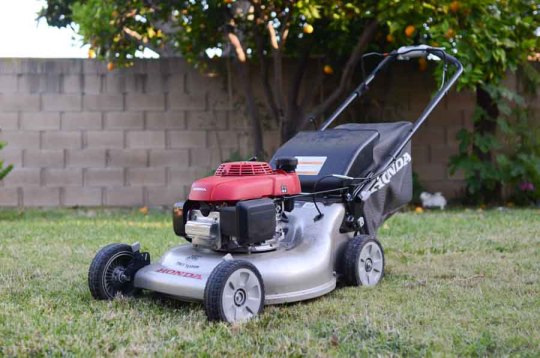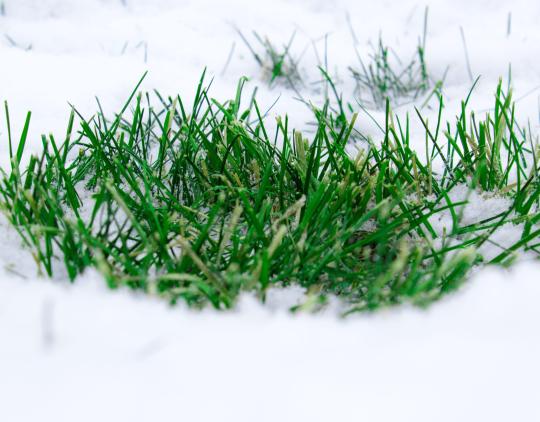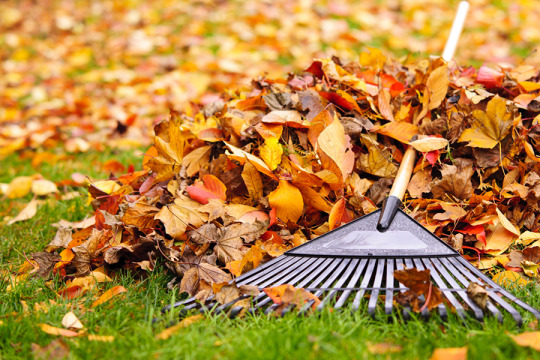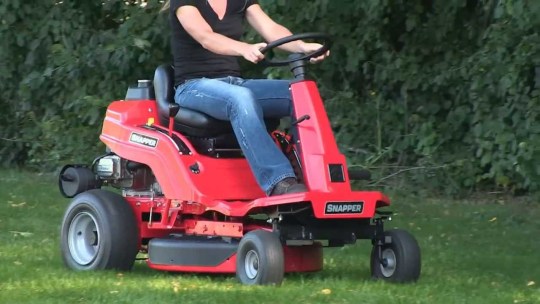Text
Ten Handy Mowing Tips:
Don’t cut the grass too short
Every grass type has an optimal cutting height, and you’re better off on the high side of that height. Here are a few reasons. The grass blade is the food factory of the plant. Short blades just can’t generate as much food as long blades. Long blades also shade and cool the soil. That means weed seeds are less likely to sprout, and you won’t have to water as often because water won’t evaporate as fast. Not sure what type of grass you have? Take a sample to a garden center for identification.
Leave the clippings where they fall
Don’t capture the clippings in a bag; let them lie. They’ll release nutrients into the soil and form a mulch to help keep moisture in the soil. The only reason to capture the clippings is if you’ve waited too long to mow. Piles of clippings created from cutting long grass can smother the grass beneath.
Self-propelled mowers deliver an even cut
Pushing a lawn mower is great exercise, but if a finely manicured yard is more important than losing your beer belly, you’d be better off with a self-propelled model. Self-propelled mowers deliver a smoother cut because the cutting speed stays consistent, and all four wheels are more likely to stay on the ground when hitting a bump or going up hills.
Mow with sharp blades
Dull mower blades rip through the grass blades instead of slicing them cleanly, and that stresses the plant. You can always tell a lawn that’s been mowed with a dull blade because it looks brown on the top. Get on your hands and knees and you can actually see the damage.
Cut short before winter
Just this one time of the year, set your mower to cut 1-1/2 or 2 in. and mow your grass short. That’ll do a couple of things. First, it’ll lessen the likelihood of snow mold. And second, tall grass blades won’t lie down and smother the new grass next spring.
More here!
0 notes
Text
Tips for Safe, Efficient Lawn Mowing:
Mowing a lawn is one of those skills that many people imagine is too easy to require instructions. It is also a skill for which most people could really use some good information. Here are some best-practice tips for mowing your lawn safely and with good results.

Choose the Right Mower
Whether you are buying a mower or borrowing equipment, choose a mower that is right for the job. If the lawn is less than 500 square feet, consider a reel lawnmower. This still-relevant relic is less noisy than gas mowers and simpler to use than electric mowers with cords that can be a nuisance. For larger lawns, a power mower is faster, and its grass-catcher and mulching options will save time on clean up. Do not bother with a riding mower unless you have at least an acre of lawn to care for.
A battery-powered mower is a great option on every level. These mowers burn no gasoline and use no oil, so they are environmentally friendly. And most models are considerably quieter than mowers with gasoline engines. Because they have no power cords, battery-powered mowers are quickly taking over the electric market, and many manufacturers now offer very dependable models.
More here!
0 notes
Text
Mowing Tips for a Healthy Lawn:
Discover the basics of mowing and why it’s so vital to growing a healthy lawn.
Mowing seems simple enough, but each time you cut your grass you’re paving the way for your lawn’s success or failure. Mow correctly, and you’ll groom turf that’s healthy, drought-tolerant and thick enough to crowd out weeds. Mow incorrectly, and your lawn will struggle to survive. Time mowings so you’re never removing more than one-third of the total leaf surface (of a single grass blade) with each cutting.

Scalping Lawn
Avoid scalping grass, which is cutting it too short. A scalped lawn is vulnerable to diseases and weed infestation. Scalped turf tends to be weak and sparse, which exposes soil. One of the No. 1 contributors to weed success is exposed soil that allows weed seed to take root. A sparse lawn also lets sunlight reach weed seedlings and give them a boost. Grass that’s consistently cut too short has a poorly developed root system, which makes the lawn more susceptible to serious damage from drought or high temperatures.
Sharpen Mower Blade
Keep your mower blade sharp to get the best results from each mowing. A sharp blade cuts grass cleanly, while a dull blade tears grass, creating a jagged, uneven edge. These tears create openings for pests and diseases to enter grass blades. A lawn that has been cut with a dull blade develops a whitish or brown hue as the tips of individual grass blades die back. Sharpen blades at least a few times during the mowing season. Avoid mowing over thick branches or stones to reduce blade dulling or even damage. Consider purchasing an extra mower blade, so that you always have a sharp blade at the ready.
Click here!
0 notes
Photo

Happy Holidays! From the Hank's Mower Repair
0 notes
Text
Winter Lawn Care Tips for a Better Spring
Fertilizing in the Winter
Late fall or early winter are the best times to fertilize cool season grasses. Since the majority of the lawns in North America are made from these grasses, like Bermuda and bluegrass, it is a good bet your yard has a typical cool season blend.
Before the first freeze, give your lawn a thorough fertilizing to replace all of the nutrients that can be lost from the soil during the hot summer months. Once the weather turns cold, the fertilizer will remain in the soil and feed your lawn’s roots all winter long.
When spring comes your lawn will be full of healthy, lush, green grass that has been feeding on good fertilizer nutrients underneath the snow.

Mowing Strategies
During the last month of the summer you should gradually lower the cutting base of your lawn mower each time you mow the lawn. Slowly cutting your grass shorter will allow it to winter well without shocking it by cutting it all off at once.
If you leave your lawn too tall during the winter months it will be prey to field mice and other burrowing animals that want a warm place to sleep. Mice can destroy large parts of your lawn by building nests. They create dead spots where they spend all of their time as well as pulling up large amounts of grass to build their structures.
Make sure your grass is as short as possible at the end of the season. Short grass also protects any new growth that may be more fragile near the end of the growing season.
More here!
0 notes
Text
How to Care for the Lawn in Winter:
In most parts of the country, lawn grass goes dormant in the winter. In the south, cool-season rye grass is often over seeded into the turf to maintain a green lawn. In the north, it's too cold for any grass to grow, so we wait patiently for spring, sometimes under snow cover, sometimes not. However, lawn care doesn't quite end in the winter. Try these tricks to keep your yard healthy.
Fertilize
Apply fertilizer with a spreader. As you move the machine back and forth over the grass, grip the handle like a trigger, it releases pellets when you "shoot." Follow the instructions on the fertilizer package. Apply only the recommended amount. Be careful because too much fertilizer can burn your grass.
Aerate the Lawn
Provide some extra air for grassroots by aerating your lawn. Use a spade to take out spikes of soil across your lawn to make holes for planting seeds. If your lawn is large, you might want to rent a motorized aerator or a manual one.
Spread Cool-Weather Grass Seed
Purchase grass seed that says "cool season" or "cool weather" on the package, such as most fescues. You can sprinkle the seed over the lawn with the same spreader you used for the fertilizer. Try to spread the seed evenly so you won't have clumps of grass later.
Rake and Water the Lawn
Drag a rake over the lawn to break up soil clumps and cover the seeds a bit. Water the lawn with the garden hose spray. After that, keep the soil moist, don't let it dry out.
More here!
0 notes
Text
Lawn Care Musts for Your Fall Yard:
Among turf care experts, it's a well-known fact that the best way to ensure a thick, green, and healthy lawn in the spring is to give it some well-timed care in the fall—in other words, right now. But according to Scott Frith, CEO of Lawn Doctor, a lawn care company with more than 200 franchises around the country, many homeowners make the same basic mistakes before grass goes dormant, and then wonder why their grass isn't doing better the following year. Wonder no more. Here is Frith's seven-step program to getting a beautiful lawn next year.

1. Remove the leaves.
A carpet of colorful autumn leaves may look nice and be fun to play in, but they're no good for grass. They block the light and trap moisture, potentially fatal knockout punches for the unlucky turf underneath. So when the leaves are falling, blow or rake them away as often as you can. Even after the trees are bare, continue raking out the corners where the wind piles leaves up. If you don't, come spring the grass under that soggy, decaying mat will be dead.
2. Keep cutting, but to the correct height.
Don't put that mower away yet. Grass continues to grown up to the first hard frost, and so will need regular cuts to keep it at an ideal 2½- to 3-inch height. If you let it get too long, it will mat and be vulnerable to fungi like snow mold. Cutting grass too short is just as bad, because it curtails the root system—root depth is proportional to cutting height—and impedes the lawn's ability to withstand winter cold and dryness. Regular mowing also gets rid of those pesky leaves, chopping them up and leaving behind a soil-enhancing mulch.
Full article here!
0 notes
Text
Maintenance Tips to Keep Your Lawn Mower Running
Whether it's sharpening blades or getting a professional tuneup, follow these maintenance tips to help your mower run longer.

Few pieces of lawn care equipment take a beating like the lawn mower, yet this popular appliance is often neglected until it won't start or something breaks.
A lack of preventive maintenance almost guarantees an early death for your lawn mower, but you don't have to be a mechanic to keep it buzzing all summer long.
1. Read the owner’s manual
"It tells you how the maker of your mower wants you to take care of it," says Chris Arvin, owner of highly rated Mow Better in Greenfield, Indiana. "It’s in their best interest to keep you, the customer, happy with their product so when it finally wears out in 10 to 15 years, you’ll buy another."
2. Drain the gasoline at the end of each mowing season
Lawn mower repair technicians say old gasoline is one of the main suspects when a mower won’t start. Arvin says you should run the remaining gas out of the mower or drain it at the end of each mowing season, and always use fresh gas in the spring.
3. Check the oil
Monitor the oil level in your mower and look for floating debris or oil that appears dark black in color. Old or contaminated oil should be drained and replaced. To change the oil, remove the drain plug underneath the mower and allow it to drain completely. If your mower doesn't have a drain plug, you'll need to carefully tilt the mower on its side and drain the oil through the fill hole. Be sure to consult your owner's manual for the correct method and type of oil to use.
More Here!!
0 notes
Text
How to Maintain a Lawn Mower
Regular routine maintenance is an important part of caring for your lawnmower. By regularly inspecting for (and repairing) wear and damage, you will improve your lawn mower's performance and extend its life. However, there's no need for you to go to a mechanic every time your lawnmower rumbles strangely. Learn how to fix it yourself! All you should need are some basic tools and some elbow grease.

Prior to starting, do a close visual inspection, cleaning out any debris, then:
Tighten or replace any loose nuts / bolts.
Sand, prime and paint rusted structural parts.
Replace or coat any bare or frayed wiring connections.
Remove the spark plug lead from the spark plug and move it away from cylinder head. Always do this before attempting any repairs to a lawnmower that require turning the engine. If you can't start it then first check your spark plug.
Position your mower.
Tip it with care. There is no one rule fits all for tipping two or four stroke engines.
It is best not to tip, but if you do you should remove the air filter so that it does not become saturated with oil or gas and be prepared for oil and or gasoline spillage! Most mowers now have a fuel line between the carburetor and fuel tank, and it is a good idea to clamp this in some way. Small needle nose vise grips with rubber hose slid over each jaw work great but should clamp only tightly enough to stop fuel flow.
If your lawnmower is a "four stroke" mower (separate gasoline and oil), never tip it on its side with the spark plug to the ground. Most four strokes have a crankcase vent that routes to the air filter box and will pour or seep oil into the air filter or carburetor throat if they are tipped with the spark plug pointing skyward.
If your lawnmower is "2 stroke" (oil and gasoline mixed) turn off the fuel tap. You can tip a two stroke mower almost any way that is suitable to you, as long as the fuel doesn't spill from the tank.
However, be aware that practically all four stroke mower engines have a float type carburetor that can leak fuel if tipped in a particular position relative to how the carburetor is positioned. They can either pour fuel into the air filter or into the combustion chamber, if the intake valve is open.
Click Here for More!
0 notes
Text
How to Maintain Your Lawn Mower Engine

Tune-up: Learn how to tune-up your engine. Tuning up is good for your engine and the environment. It will also save you money. Our interactive demo walks you through four easy steps for tuning up your mower. It is even easier with a Briggs & Stratton Maintenance Kit. According to environmental impact data, a properly tuned and maintained lawn mower makes a big difference:
Reduces mower emissions by up to 50%
Reduces costly fuel consumption up to 30%
And, extends the life of your engine!
To keep your mower operating smoothly throughout the lawn care season, remember these maintenance tips:
Oil
Check the oil level regularly - ideally every time you mow. Add oil up to the fill line on the dipstick as needed.
If you have a new mower, change the oil after the first five hours of use. After that, change the oil after every 50 hours of use or at the beginning of each lawn care season.
Keep the Blades Sharp
Keep your mower blades sharpened so that you are cutting your lawn cleanly and not "tearing" the grass. Your lawn mower dealer can do this for you.
Use Clean, Fresh Fuel
Clean, fresh fuel is essential for an engine to start quickly and operate efficiently. Gasoline deteriorates after 30 days and can negatively affect engine and starting performance.
Briggs & Stratton Fuel Stabilizer Plus gasoline additive can keep your fuel fresh year-round and help prevent gum deposits in the carburetor.
Or purchase a Fresh Start® continuous fuel preserver cap and cartridge for up to six months of hassle-free starting.
Cleaning a Clogged Mower Deck
When the mower deck is clogged with clippings, turn off the mower, disconnect the spark plug and then use a garden hose to wash away the material.
After spraying, remove any remaining clumps of grass that may interfere with the blade by using a stick or other tool - never use your hands or feet.
More Here!
0 notes
Text
Mowing Tips for a Healthy Lawn
Discover the basics of mowing and why it’s so vital to growing a healthy lawn.
Mowing seems simple enough, but each time you cut your grass you’re paving the way for your lawn’s success or failure. Mow correctly, and you’ll groom turf that’s healthy, drought-tolerant and thick enough to crowd out weeds. Mow incorrectly, and your lawn will struggle to survive. Time mowings so you’re never removing more than one-third of the total leaf surface (of a single grass blade) with each cutting.

Scalping Lawn
Avoid scalping grass, which is cutting it too short. A scalped lawn is vulnerable to diseases and weed infestation. Scalped turf tends to be weak and sparse, which exposes soil. One of the No. 1 contributors to weed success is exposed soil that allows weed seed to take root. A sparse lawn also lets sunlight reach weed seedlings and give them a boost. Grass that’s consistently cut too short has a poorly developed root system, which makes the lawn more susceptible to serious damage from drought or high temperatures.
Sharpen Mower Blade
Keep your mower blade sharp to get the best results from each mowing. A sharp blade cuts grass cleanly, while a dull blade tears grass, creating a jagged, uneven edge. These tears create openings for pests and diseases to enter grass blades. A lawn that has been cut with a dull blade develops a whitish or brown hue as the tips of individual grass blades die back. Sharpen blades at least a few times during the mowing season. Avoid mowing over thick branches or stones to reduce blade dulling or even damage. Consider purchasing an extra mower blade, so that you always have a sharp blade at the ready.
Adjusting Mower Height
Adjust mower height throughout the growing season. For instance, shift the cutting deck higher in summer and allow grass to grow longer. Taller grass helps shade soil, which prevents weed growth and slows water evaporation from soil. Taller grass also develops deeper roots, which creates a lawn that can withstand drought better. In late autumn, in regions where winter brings snow cover, lower the cutting deck for the last mowing of the season to help prevent snow mold from forming on grass.
More Here!
0 notes
Text
Year-Round Lawn Care Tips
No matter what time of the year you’re growing grass, brush up on your lawn care routine with these quick and easy tips.
Warm or Cool Season?A healthy, well-tended, weed-free garden with crisp edges is actually an easier garden to maintain. To keep weeds at bay, apply a protective layer of mulch and Preen. For seasonal gardening tips, see www.preen.com.

Grass Spread by Runners
Warm-season grasses, including Bahia, Bermuda, centipede, St. Augustine and zoysia spread by runners, above and/or below ground. This enables them to create a thick mat of turf that, when maintained properly, crowds out weeds with ease. The runners also mean that these warm-season grasses make great choices for erosion control. Runner-type grasses grow easily as sod, because the running stems hold the sod pieces together. With Bermuda grass, the runners spread aggressively, and you may see grass shoots appearing in flower beds and other non-lawn areas of your yard. To corral this grass, install a barrier edging that extends into soil to halt the spread of runners.
Bunch Grass
Cool-season grasses, like the fescues and ryegrass, are bunch grasses. A lawn of fescue is actually a host of individual grass plants that, as they grow, form bunches. These bunch grasses are most often sown from seed. Bunch grasses don’t naturally hold together in the form of sod, unless the sod grower uses a biodegradable net at planting time. The net holds the bunches together, enabling the grass to be harvested, rolled and installed as sod. One cool-season grass, Kentucky bluegrass, is not a bunch grass but spreads by runners.
Mowing the Grass
Mowing is probably the most time consuming activity of lawn maintenance. No matter what type of grass you tend, it’s vitally important to maintain a sharp mower blade, so that you’re cutting grass blades cleanly and not tearing them, which creates openings for pests and diseases to enter. It’s also equally key to know the proper mowing height for your turf type. For warm-season grasses, turf height varies by grass type, covering a range from 1 to 4 inches. Research the type of grass you have, and maintain it at the ideal height.
Beware of Scalping
For bunch grasses, cutting grass too short can be a kiss of death. When those individual grass plants are scalped, they have to use food reserves stored in the roots to regenerate the plant. Depending on the season and the lawn’s health, recovery may not be possible. Never remove more than one third of total grass blade length at a single cutting.
More Here
0 notes

